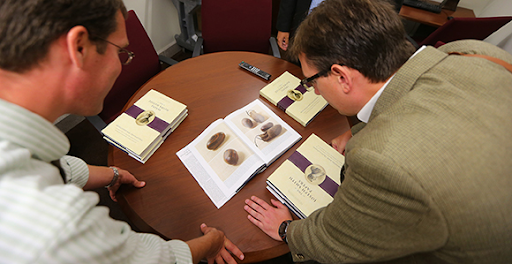
(Image source: ChurchofJesusChrist.org)
The early years of the Mormon Church were marked by the visionary experiences of its founder, Joseph Smith. Central to these experiences were his use of seer stones, objects imbued with properties believed to enable their user to receive divine revelations and insights. This practice, rooted in localized folk traditions, played a significant role in the formation of early Mormon beliefs. However, as the theology of Mormonism evolved and matured, Joseph Smith apparently stopped or significantly reduced his reliance upon seer stones, raising questions about the role of such tools in Mormonism and the reasons behind this shift.
Seer Stones in Early Mormonism
Joseph Smith seer stone usage can be traced back to his youth in upstate New York, a region rife with folk traditions. Smith is reported to have owned several seer stones, the most famous of which were called the “Urim and Thummim,” a pair of stones set in a silver frame that were said to have been used in translating the Book of Mormon. Smith also utilized other stones, such as the “Brown Seer Stone,” a chocolate-colored stone he is said to have found while digging a well.
Seer stone usage was not uncommon in the 19th century, especially in rural communities. Seer stones were believed by many to allow a person to receive hidden truths, locate lost objects, and communicate with spiritual beings. For Joseph Smith, such stones were instruments for receiving divine revelations, including translating the text of the Book of Mormon, whose location, buried in a hillside near his home of Palmyra, New York, was shown to him by an angel named Moroni.
Historical Examples of Seer Stones
Seer stone usage, in and of itself, is not unique to Joseph Smith or Mormonism. Throughout history, various cultures and societies have utilized similar objects for divination and spiritual purposes. For example, in ancient Greece is recorded the usage of “crystal balls” or “scrying stones” among oracles and seers. These stones, often made of polished quartz or beryl, were believed to facilitate communication with higher powers and provide valuable insights into future events.
In medieval Europe, the practice of scrying, or gazing into a crystal ball or mirror in hopes of receiving visions, was prevalent among certain individuals in a community thought to possess mystical gifts or training. These individuals believed that the reflective surface of the crystal or mirror acted as a way to reach into the spiritual realm, allowing them to obtain divine messages and guidance.
Among Native American cultures the use of “seeing stones” or “spirit stones” was also common. Such stones, often found in natural settings such as rivers or caves, were believed to possess spiritual powers for the purposes of divination, healing, and communicating with ancestors.
The Transition Away from Seer Stones
Despite the role of the Mormon seer stone in the formative years of the Church of Jesus Christ of Latter-day Saints, Joseph Smith apparently used them less and less over time. The reasons for this shift are not entirely clear, but several factors may have contributed to it.
- Doctrinal Development: As the Mormon Church expanded and developed its theology, the emphasis shifted from the use of physical objects like seer stones to more intuitive methods of receiving guidance and revelation. The LDS Church began to emphasize the priesthood and the hierarchy of leadership, moving away from the more individualistic and mystical methodologies.
- Persecution and Criticism: The use of seer stones and other folk traditions made the early Mormons a target of persecution and ridicule. Critics of the Church, such as the author E.D. Howe in his book “Mormonism Unvailed,” described Smith’s use of seer stones as evidence of his fraudulent character and unorthodox practices. Smith may have chosen to downplay or abandon his usage of seer stones to distance himself from such criticisms.
- Personal Development: As Joseph Smith’s understanding of divine revelation and his role as God’s prophet and Church leader evolved and expanded, his spiritual gifts may have developed in such a way that made his spiritual sensitivities less reliant upon physical tools or other devices, allowing him to receive divine revelation or inspiration more directly without secondary aid.
Comparative Analysis with Historical Examples
Comparing Joseph Smith’s use of seer stones with historical examples highlights the wider belief that physical objects could be used to receive divine guidance and direction that woud provide insights into the unknown.
While Joseph Smith’s use of seer stones may have diminished in later years, the concept that such devices were used continues to stimulate the interest of both critics of and believers in the Mormon faith. The Book of Mormon, translated with the aid of the Urim and Thummim, remains foundational to understanding the history of Joseph Smith and the Mormon Church as an institution. After all, the concept of receiving divine guidance and revelation continues, not only for leaders of the LDS Church, but also for everyday Church members, and remains central to the tenets of the Mormon faith.
In recent years, there has been a renewed interest in seer stones. The publication of photos of the “brown seer stone” by the Church Historian’s Press in 2015 sparked fresh discussions about the role of seer stones in the early church and their significance in Mormon theology. This rekindled interest highlights the ongoing desire to better understand the origins and development of the Mormon Church.
Concluding ThoughtsJoseph Smith’s usage of a seer stone, or multiple seer stones, in the foundational years of the Mormon Church reflects the influence of folk traditions on early Mormon beliefs and practices. While Smith apparently developed his revelatory gifts to a point that he no longer required such devices, curiosity with regard to them continues to shape public and private perceptions of Mormon theology. Understanding the role of seer stones may provide valuable insights into the dynamic relationship between formal religion rites and practices and deeply embedded cultural traditions.

Fact Checked by Mr. Kevin Prince, Source Expert
Kevin Prince is a religious scholar and host of the Gospel Learning Youtube channel. His channel has garnered over 41,000 subscribers and accumulated over 4.5 million views. Mr. Prince also created the Gospel Learning App, a reliable platform where individuals seeking truth can access trustworthy answers to religious questions from top educators worldwide.
About Mormonism Explained
Mormonism Explained is a resource that was designed to provide objective and factual information about Mormonism, its history, doctrines, and policies. Our team of researchers consults experts and primary sources to present factual information on a variety of topics relevant to the Mormon Church.
Tags

